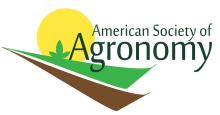Resource information
Native warm-season grasses have potential to increase the ecosystem services associated with grazing lands and to provide a source of forage for livestock. In the upper Midwest, minimal region specific information is available to grass-based farmers on how to manage native pastures for long-term productivity and persistence. Wildlife biologists suggest delaying defoliations until mid-summer to preserve grassland bird habitat, yet production-based management recommendations warn against late season defoliations. Moreover, the source of seed to use for pasture establishment, cultivar or locally harvested seed (LHS), is unclear. We initiated an on-farm experiment to evaluate the effects of two rotational grazing schedules, June to July or July to September, for differences in vegetation cover, vigor, yield, and nutritive value of paddocks seeded with native warm-season grass cultivars or LHS. After 2 yr, native grass cover was similar across all treatments. Vigor, as measured by spring etiolated growth, was sustained under grazing and across seed sources for the dominant native grasses big bluestem (Andropogon gerardii Vitman) and Indiangrass [Sorghastrum nutans (L.) Nash]. Total yield was greatest when grazing was deferred until July, but this resulted in decreased nutritive value for both seed sources. These results indicate that native warm-season grasses have potential to persist under rotational grazing in upper Midwest pasture systems and that pasture performance is controlled by the timing of the first grazing cycle. The lack of a consistent seed source effect suggests that the LHS and cultivars used in the study are suitable for pasture use in the region.



